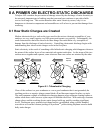
A Primer on Electro-Static Discharge Teledyne API M701H High Performance Zero Air Generator
8-4 06712B (DCN5875)
As long as my analyzer is properly installed, it is safe from damage caused by static
discharges: It is true that when properly installed the chassis ground of your analyzer is tied to
earth ground and its electronic components are prevented from building static electric charges
themselves. This does not prevent discharges from static fields built up on other things, like you
and your clothing, from discharging through the instrument and damaging it.
8.4 Basic Principles of Static Control
It is impossible to stop the creation of instantaneous static electric charges. It is not, however
difficult to prevent those charges from building to dangerous levels or prevent damage due to
electro-static discharge from occurring.
8.4.1 General Rules
Only handle or work on all electronic assemblies at a properly set up ESD station. Setting up an
ESD safe workstation need not be complicated. A protective mat properly tied to ground and a
wrist strap are all that is needed to create a basic anti-ESD workstation (refer to figure 12-2).
Wrist Strap
Protective M at
Ground Point
Figure 8-2: Basic Anti-ESD Work Station
For technicians that work in the field, special lightweight and portable anti-ESD kits are
available from most suppliers of ESD protection gear. These include everything needed to
create a temporary anti-ESD work area anywhere.
Always wear an Anti-ESD wrist strap when working on the electronic assemblies of your
analyzer. An anti-ESD wrist strap keeps the person wearing it at or near the same potential as
other grounded objects in the work area and allows static charges to dissipate before they can build
to dangerous levels. Anti-ESD wrist straps terminated with alligator clips are available for use in
work areas where there is no available grounded plug.
Also, anti-ESD wrist straps include a current limiting resistor (usually around one meg-ohm) that
protects you should you accidentally short yourself to the instrument’s power supply.
Simply touching a grounded piece of metal is insufficient. While this may temporarily bleed off
static charges present at the time, once you stop touching the grounded metal new static charges
will immediately begin to re-build. In some conditions, a charge large enough to damage a
component can rebuild in just a few seconds.


















